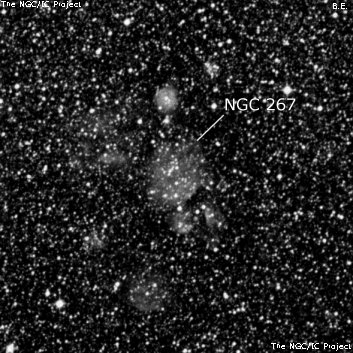
John Herschel discovered NGC 267 = h2352 in the SMC on 4 Oct 1836 and recorded "a faint, pretty large, cluster of very small stars. It is the preceding knot (or centre of condensation) of the resolvable portion of the Nubecula Minor which fills the subsequent field and consists of irregularly scattered clustered stars 12...20th mag." His position is on the southwest side of the cluster/nebula.
Pietro Baracchi observed this nebulous cluster (labeled as "I prime" on 17 Dec 1887 with the 48" Melbourne telescope. He logged it as "Cl; F; pL; very faint stars. Not observed last night."
400/500mm - 18" (7/10/05 - Magellan Observatory, Australia): at 228x this SMC cluster with nebulosity appears as a fairly faint, fairly large irregular glow ~2'x1.4'. The surface was grainy with a half-dozen mag 14 stars resolved (Hodge Association 15). There was a good response using a UHC filter, which increased the size of the visible nebulosity. Collinear with two mag 10.5 stars ~6' SE. A string of brighter stars to the north heads east for 17' towards NGC 290. LHa 115-N25, a very small detached piece ~2' N, appears as a 15" glow and increases the total size to nearly 5'.
600/800mm - 25" (10/17/17 - OzSky): at 244x + NPB filter; bright, very large nebulous cluster, slightly elongated N-S, ~2'x1.6'. Removing the filter, several faint stars were peppered across the glow. Very good contrast gain using the NPB filter.
SMC-N25 is a separate 1' patch 2' NNE that appeared fairly bright (with the filter), moderately large, round glow, ~50" diameter. SMC-N28 is a very large, lower surface brightness patch (barely detached from NGC 267), ~1.5' diameter, centered ~2.3' ENE of NGC 267. On close inspection it was divided into two sections on the north and south side and weaker in the center. The southern section (SMC-N28A) was extended E-W and slightly brighter.
Notes by Steve Gottlieb